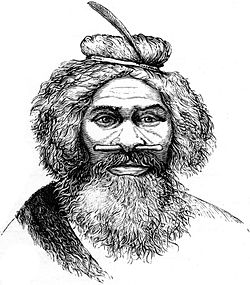attempts to solve them being little more than guesses. Some of them have become associated with religious or superstitious observances, and so have been spread and perpetuated; some have been vaguely thought to be hygienic in motive; most have some relation to conventional standards of improved personal appearance; but, whatever their origin, the desire to conform to common usage, and not to appear singular, is the prevailing motive which leads to their continuance.
The most convenient classification of these customs will be one which is based upon the part of the body affected by them, and I will begin with the more superficial and comparatively trivial—the treatment of the hair and other appendages of the skin.

Fig 1.—Australian Native, with Bone Nose-Ornament.
Here we are at once introduced to the domain of Fashion in her most potent sway. The facility with which hair lends itself to various methods of treatment has been a temptation too great to resist in all known conditions of civilization. Innumerable variations of custom exist in different parts of the world, and marked changes in at least all more or less civilized communities have characterized successive epochs of history. Not only the length and method of arrangement, but even the color of the hair, is changed in obedience to caprices of fashion. In many of the islands of the Western Pacific, the naturally jet-black hair of the natives is converted into a tawny brown by the application of lime, obtained by burning the coral found so abundantly on their shores; and, not many years since, similar means were employed for producing the same result among the ladies of Western Europe—a fact which considerably diminishes the value of an idea
